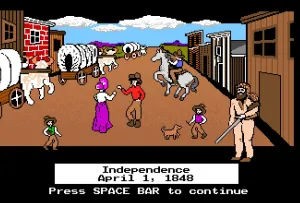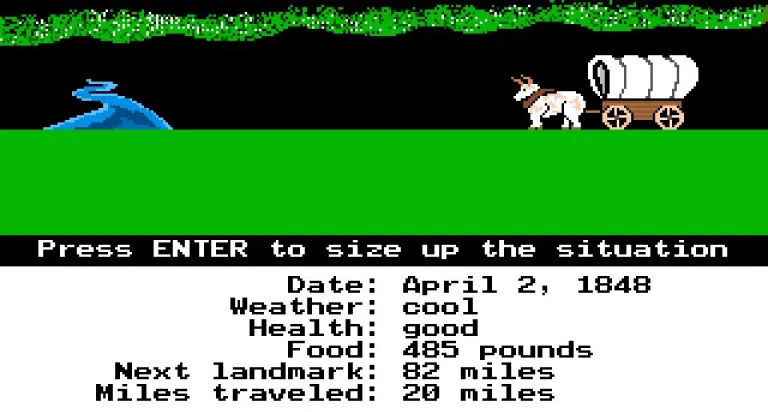A Series of Interesting Choices With The Oregon Trail for ESL
Hello everyone and welcome to another edition of the TESOL Games and Learning blog!
Sid Meier, creator of the classic video game series Civilization, once described video games as a series of interesting choices. It is a wonderful way to think about how to use video games in the classroom, as the outcome of those interesting choices create experiences for our students which they can compare with one another or even with real world events. This month, let’s explore how students can connect in-game experiences to the real world with the game The Oregon Trail.

The 1990 edition of The Oregon Trail can be played for free online at the Internet Archive.
For many Americans of a certain age, The Oregon Trail was a staple of their school years. In the late 1980s, it seemed to be on just about every classroom computer. In the game, players live the life of an American emigrant traveling from Independence, Missouri to the Oregon country. Each step of the way, players must make choices that influence their chances of successfully completing the journey. Everything from when to begin the trip to how much food and clothing to pack to when to rest or attempt to cross a raging river is up to the player. Along the way, they can learn more about the life of travelers on the trail. (Play the 1990 edition of the game for free online.)

Players must manage food, distance traveled, and all the unexpected events that occur along the trail.
Students’ adventures along the Oregon Trail can be paired with real world history via a wealth of maps provided by the U.S. National Parks Service (NPS). Students can view the path of the original trail imposed on a current map of the United States on the NPS National Trails page. NPS also has a website where students can view different landmarks and museums which mark the historical significance of the Oregon Trail.

Students can see real world locations along the trail at the National Park Service’s Oregon Trail Page.
Finally, students can use mapmaking tools, such as this one, to document their own adventures along the trail and in the process keep an interactive diary of all the choices, decisions, and experiences they have while playing the game. These maps can be the foundation for a rich classroom speaking exercise as students share a map of their adventure with their classmates.
Encouraging students to keep a diary of their in-game experiences can create an opportunity for a writing and reading experience, too. Websites such as the Oregon Trail Center and Oregon Pioneers document the diaries of those who traveled the trail. One such letter written by James Looney on October 27, 1843 is practically an instructional manual for players getting ready to start on the trail:
Let your load be your provisions—flour and bacon. Put in about as much loading as one yoke of cattle can draw handily, and then put on three yoke of cattle and take an extra yoke for a change in case of failure from lameness or sore necks, and you can come without any difficulty. The road is good, much better than we expected, but is long.
I would advise you to start as soon as the grass will admit of, we might have started a month sooner than we did, and then we would have been here to have gone through with our cattle this winter. We left Independence the 22d of May, and we are just about a month too late.
After completing the game, students can explore these diary entries with an understanding of the challenges of the trail by having played the game. While the game will only be a rough approximation of the experiences of the Oregon Trail, it does provide students with a context through which to engage the maps, diaries, and other historical artifacts of the trail.
Recently, a new version of the game was released that includes a more complex portrayal of the indigenous people whose lands were traversed by the settlers. It allows for players to see more of the lives of Native Americans and play through storylines from their perspective. Having half the class play the settler experience and half play through the Native American experience could add another layer of history and perspective.
Do you know of any other games that pair well with other forms of media like the example here? If so, feel free to share your ideas in the comments.
Until next month, play more games!

